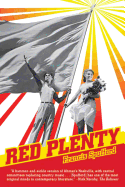
Rich with ham-faced Russian bureaucrats, vodka, Siberian pines and, most notably, Soviet optimism at mid-20th century, Francis Spufford's innovatively styled novel Red Plenty combines complex economic theory with snapshots of ordinary people dealing in different ways with the hopes and realities of central planning. What could have been a dry economics lesson is entertaining and intriguing, buoyed by Spufford's unusual, fully realized characters and settings, treated with a sense of tragedy and farce and a refreshingly fair approximation of the scale of the failed Soviet Union's ambitions.
Unlike politically focused post-mortems, Red Plenty examines not militarism and oppression, but the massive effort of planning and meeting all the consumer needs of the gigantic U.S.S.R. To imagine the inside of the Soviet bureaucracy, Spufford mixes real characters like Leonid Vitalevich Kantorovich (whose theories on resource allocation would eventually win the Nobel Prize in economics) with imagined characters like Galina, a student who, on Party orders, heckles an American emissary during an exhibition of consumer goods.
By beginning and ending Red Plenty with Nikita Khrushchev, the leader who saw a future in which socialism would bring his citizens all they needed and more, Spufford invites the reader to see the Soviet premier as analogous of the Soviet experiment itself: a bumpkin with a bad temper who, for a moment, seemed to be on the precipice of showing the tired, hungry world a better way to live, but was brought down by small minds and the memory of his own bloodied hands. --Cherie Ann Parker, freelance journalist and book critic

